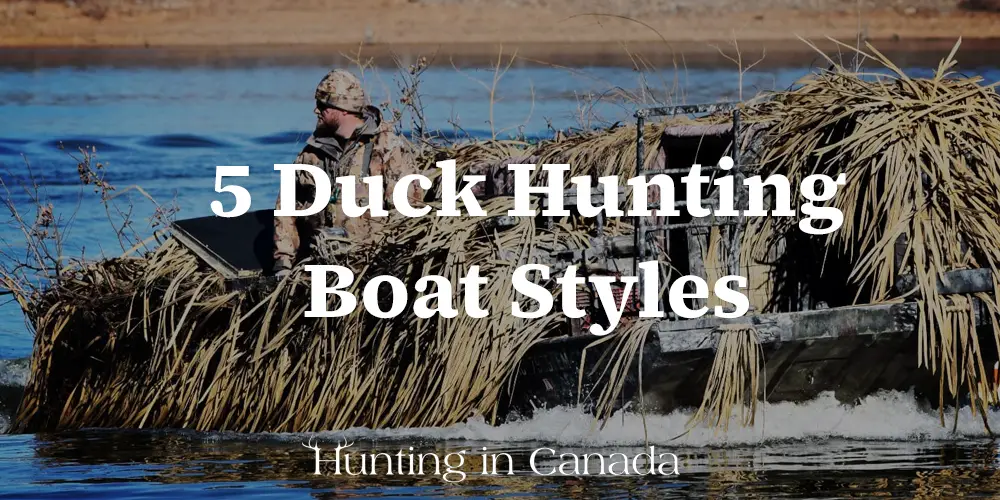Duck hunting is one of the most popular forms of waterfowl hunting. Ducks live in rivers, marshes, lakes, and oceans. Therefore using a duck boat can open up a whole new world of hunting opportunities for waterfowlers. As it is a true thing that duck hunters with boats hunt more ducks than the hunters stuck on the bank.
There are different styles of waterfowl hunting, and each of them calls for different styles of boats. So which one is the best for you depends on your hunting style, where you hunt, the amount of gear you’ll carry, how far you’ll be running, how many people you will hunt with, and any other uses you may have for the boat.
You may only need one or two boat styles, or you may need to add another bay to your garage. In this article, we will mention the 5 hunting duck boat styles so you get to know which boat style can satisfy your needs.
5 Hunting Duck Boat Styles
1. The Car-Topper
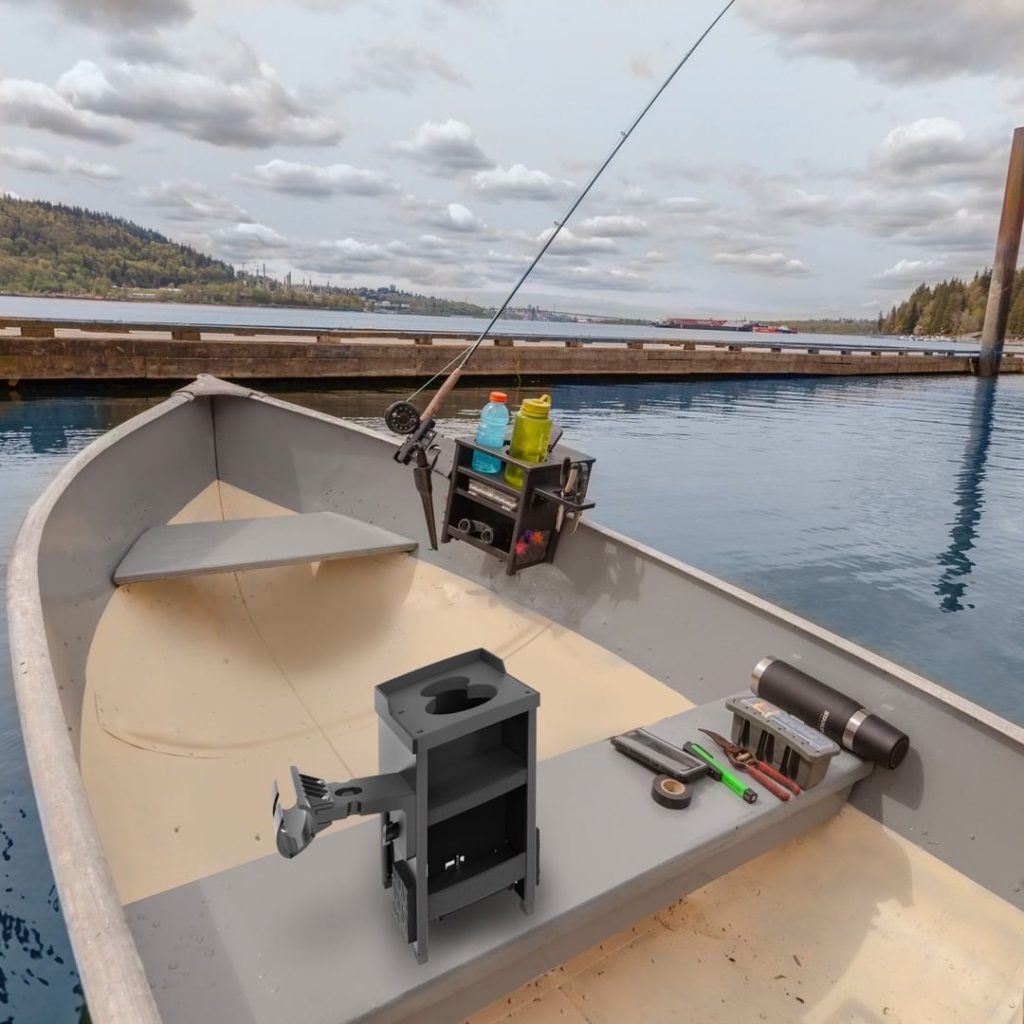
The biggest concerns for most people when they go hunting in puddles are weight, lack of it and portability. Whether you need something to go deep into public marshes or just float across small lakes, you might have to carry and drag your boat to the water’s edge and then launch the boat from the shoreline by hand.
A 10- or 12-foot aluminum Jon boat is the classic choice for duck hunters who want something that they can strap onto a car roof or throw into their truck bed. They still work fine, especially if you pair them with a small outboard or an electric trolling motor.
Fibreglass canoes are great for paddling because they’re faster and can haul more hunters and gears without worrying about capsizing. Also, they are less noisy than aluminum boats.
If you want to get your hands on a great used car-topper for cheap, try checking out the classifieds or driving around in neighbourhoods near lakes during the off-season.
You may find a few sun-bleached Jon boats and canoes that look in good condition, and you can get them with a few hundred dollars and a handshake. Spray paint some camo onto them, and all done.
2. The Mud Boat
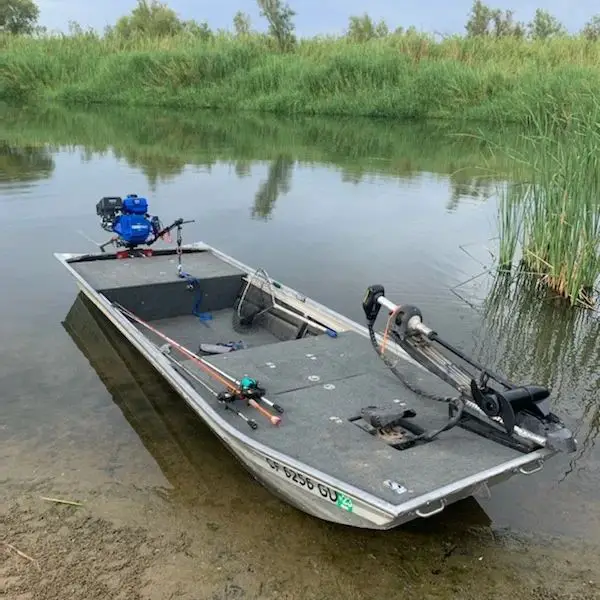
Mud motors use an engine to turn a prop, this engine is similar to what you would find in a lawnmower. They don’t rely on water for cooling the system as the traditional outboard motors do. Also, they have a pivoted mounting system on the transom and a rugged design, all of which allows them to push the boat through inches of water.
On open water, the motors are sluggish and loud ( at least compared to an outboard with the same horsepower). But to access shallow waters, the only other option is with an airboat.
Some mud motors are mounted on regular Jon boats. But specialized mud boats are built by companies such as Go-Devil. Those boats have rounded chines, and smooth bottoms that can make turns easier and even better shallow water utility.
A lot of mud boats come with handlebars by which the hunter can hang on, stand up, and steer at the same time.
3. Specialty Boats

The experience of a diver hunting from a layout boat is one that every serious hunter should have at least once in his life. In order for Bluebills, redheads, canvasbacks, and sea ducks to avoid shoreline hunting pressure, they will raft up in open water and feed on underwater shell beds.
The layout boat is an amazing way to find yourself hiding in open water right amongst the decoys at surface level. It looks like a UFO and has amazing stability even in rough water. Those boats are not for transport; you use them to hide in plain sight from geese and ducks while keeping you dry.
Sometimes other low-profile marsh boats are called layout boats. The design of these boats does not suit big-water use, but if you think of them as layout blinds to use in the water, they will be useful.
4. The River Rat
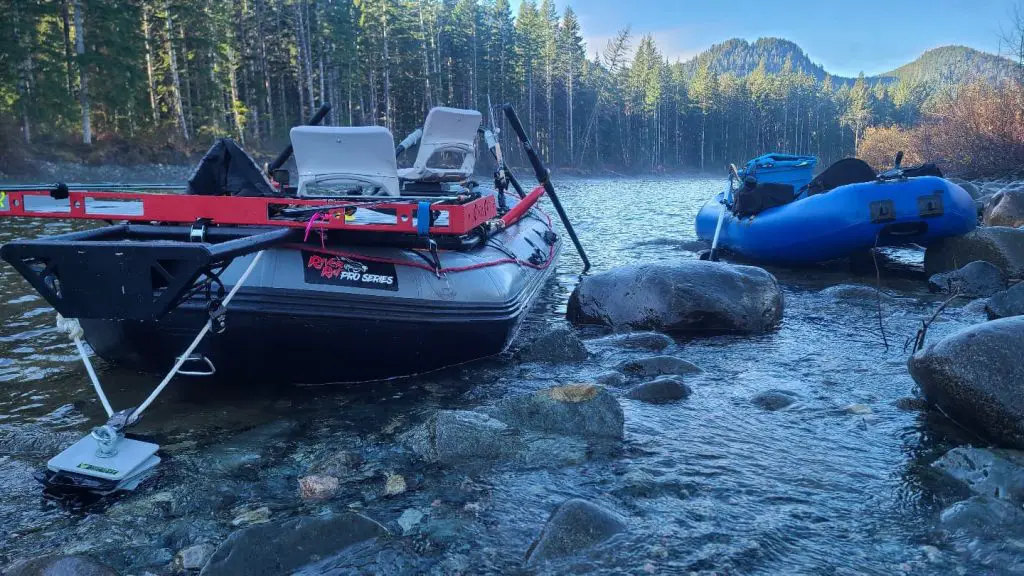
The 14 to 16-foot Jon boat with a 25-horse tiller steer motor is standard issue transportation on many of the public duck waters. The boat has been designed to comfortably seat two hunters and their gear for several miles.
The 25-horse outboard is light enough that two hunters can usually wrestle it on and off the trailer in a floodwater ditch but is also powerful enough to get you home in a surprise storm as well.
For a mobile hide, some of them are paired with a boat blind. These boats draft minimal water and bounce nicely off cypress knees and stumps.
The traditional favourite style is the flat-bottom hull, but those who prefer a smoother ride should consider a modified V – flat on the bottom with a keeled bow. This makes it easier to snake through flooded timber without getting stuck on anything in your path.
As for power, some hunters use two-stroke outboards while others prefer to go with 4-stroke outboards; each one has its pros and cons. So which one to go with depends on your preference.
5. The Fish-N-Shoot
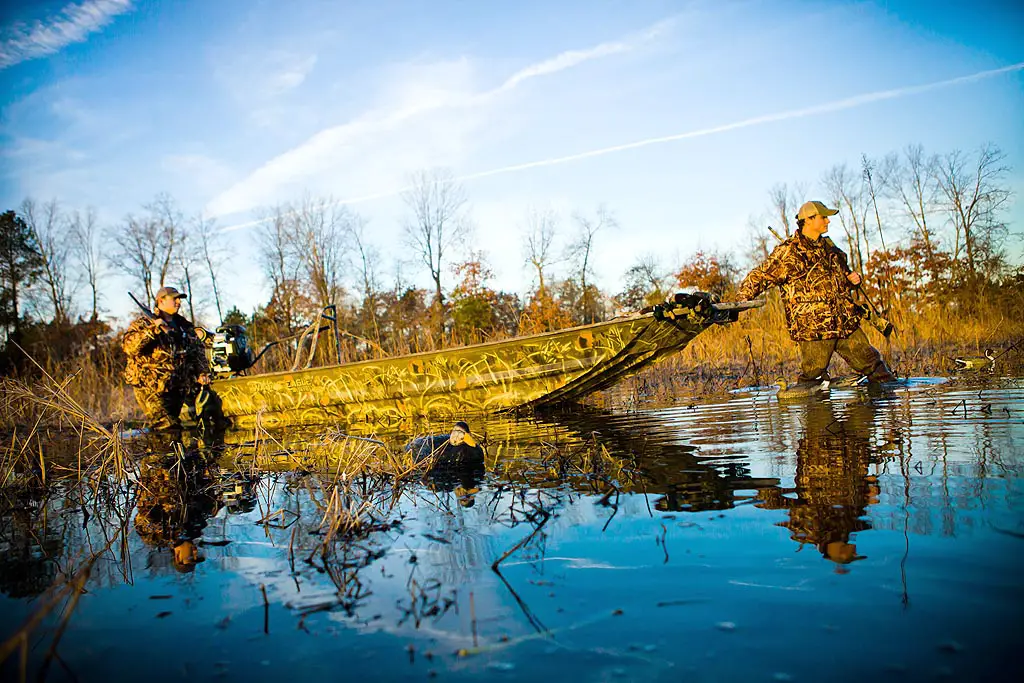
This boat has a lot of advantages, it is perfect for fishing in the spring or hunting divers and puddle ducks on major rivers and lakes in the winter.
These boats are lightweight enough to push across shallow flats but have horsepower and stability, so you can navigate moderately rough water.
However, sometimes, when you push it across a mudflat in the dark, you would wish it were lighter and paired with a mud motor. But the boat is an all-around compromise that will never let you down with a long time of use.
Since this boat can be used for both duck hunting and fishing, it’s perfect for people who like to fish and hunt but don’t have the money or room for multiple boats.
Hull Configurations
What kind of hull your boat should have is the first thing you need to know. The kind of water you will be traversing on your hunting trip will totally determine your decision. You can choose between three basic hull types, each of which has its own advantages.
Flat Bottom Boats
Flat bottom boats (Jon boats) are ideal for shallow water, especially when they are equipped with a mud motor that can better navigate the shallows. The boat’s low sides are its biggest drawback, as it cannot handle the big water requirements. The water will fill your boat in no time, and the bow of the boat will do almost nothing to split waves.
Semi-V Boats
The semi-V hull boat is a great balance between the big water resistance that comes with V-bottom boats and the shallow water flexibility of flat bottom boats. With its pointy bow, the boat will cut through waves, while the flat bottom will give you a smooth ride in shallow waters. Some of the semi-V boats are made expressly for waterfowl hunting and can easily be outfitted with a boat blind.
V-Bottom Boats
A V-bottom boat is designed to cut through big water. It is a fibreglass or aluminum boat that will make a great tender if you’re layout hunting in a remote corner of a lake. V-bottoms are heavy and stable, the high gunwales and transoms will keep water out of the boat, and the V-bottom and sharp keel will part waves and slice through the big water.
Outboard & Mud Motors
Choosing the right motor is also important. Whether or not your boat has enough power to travel through waves and strong currents or can operate in shallow water is determined by your choice of motor. Also, weight, noise, and versatility are other factors you need to check.
2-stroke
When it comes to outboard motors, there are two options to choose from. You can go with either 2-stroke or 4-stroke models.
The two-stroke outboards have been around for decades, and they have proven themself in a variety of situations. It’s lighter in weight, more portable, and also has a lower price than four-strokes. That is why they are really popular with a lot of duck hunters.
You can rely on these reliable and powerful 2-strokes to get you through the day. They also usually offer better responsiveness and acceleration than 4-stroke outboards, which is a useful asset when faced with an impending wave in a rig loaded up with hunters and hunting gear.
The downsides are that a small 2-stroke motor requires an oil/gas mix and is typically louder and less fuel efficient than a four-stroke.
4-stroke
Some waterfowl hunters choose 4-stroke outboards because they are generally cleaner, quieter, more fuel efficient, and don’t require measuring and mixing gas and oil. The largest downside to these engines is that they are heavier than 2 strokes, require periodic oil changes and are typically more expensive.
Mud Motors
If you want to get to the duck blind, you should look into mud motors. Although those machines do not perform the best out on the open water, they are the best for going through shallow water areas.
The mud motor has been a game changer for many duck hunters. It’s designed to ride over obstructions, and it offers much greater shallow water capability than traditional outboards with a rigid lower unit.
You can choose from two basic styles, which are long-tail or surface-drive. Both can be operated in just inches of water, but the surface-drive motors are great for open shallows where you can get up to plane, while the long-tail motors are great for getting around areas with weeds, branches and other obstructions.
Must-Have Duck Boat Accessories
The boat that you use for hunting ducks should be equipped with all of the basic accessories such as anchors, life jackets, and other required items. But there are some must-have items that any waterfowl hunter should consider when outfitting their duck hunting boat.
Duck Blinds
Some duck hunters will need to blind up their boats. Sometimes it may be as simple as breaking up the boat’s lines with some burlap and covering the outboard.
But many people hunt right out of the boat. In order to accommodate this need, there are pop-up style blinds that have aluminum frames with cloth blind material. You can purchase these for many Jon boats. They’re easy to install, too, as they are added with 4 mounts that can be bolted or screwed to the boat corners.
While other hunters will build wooden frame blinds, which can be quite heavy and sometimes may decrease the seaworthiness of the duck boat
Gun Boxes or Holders
Some duck boats come with built-in gun boxes that are waterproof and can even be locked. If you have the option, it’s something worth getting because they keep your shotguns safe and secure from harm. But if not, then consider adding a rigid gun box to your boat.
Decoy Boxes
Hunters use a few different ways to stow their decoys; some of them stack their decoys on the deck, others stow their decoys in bags, while some choose to build stowage boxes right into their boats. Although they work very well, using your boat for anything other than duck hunting will be hard.
Push-Poles and Spuds
Some duck hunters have a push pole in their boat. When being in an area where the hull will float but the water is not enough to operate the outboard, you can use the push pole to propel your boat.
Some hunters also have a spud which is the best way to stop your boat from drifting. The spud is a pole sharpened at one end that you can dig deep into the mud and use to tie off the boat.
Also, you can find some poles that have a point on one end and a thick Y shape to push with on the other. Those poles can serve both purposes.
Shell Holders
Shell Holders can hold up to a dozen individual shotgun shells, and they clip to the blind frame or the gunwale. Having those accessories is not absolutely necessary, but when the shooting is fast and furious, they come in handy.
What Is A Good Size For A Duck Boat?
The waters you hunt most and your hunting style determine the duck boat size. Having more space is always a good thing, but the bigger the hull, the less maneuverable and the harder it is to handle.
Also, there are other things you need to keep in mind, such as your average hunting crew, the tightness of the areas you hunt, and if you ever intend to hunt alone. So the hull should have enough space for your average hunting crew without going overboard.

